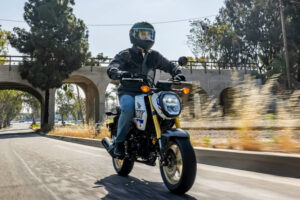Although the last Honda Reflex scooter (aka NSS250) came out more than 13 years ago, it is still one of the most sought-after maxi-scooters in the secondhand market today. In this Honda Reflex review, I’ll list all of its specs and features so you can decide if it is the right scooter for you.
The Honda Reflex is a maxi-scooter manufactured by Honda. It has a dry weight of just 375 pounds and is powered by a single-cylinder, four-stroke gasoline engine with a 249cc displacement. This scooter can reach a top speed of 82 miles per hour.
Read on to learn more about the Honda Reflex, including its key specs and features.
About the Honda Reflex
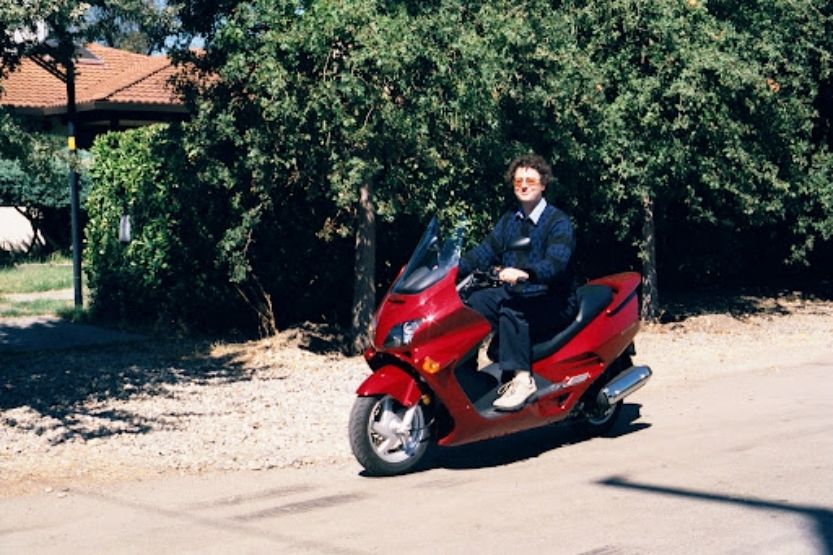
The Honda Reflex was first introduced in 2001 and remained in production until 2007. Initially, the Reflex was supposed to replace the Honda Helix, which had legendary status among scooter fans. These same fans are why Honda decided to bring back the Helix and sell alongside the Reflex.
In its seven-year run, the Reflex remained unchanged design-wise. However, the 2004 model did see the much-improved alternator so that the bike has enough power to run additional electronic accessories.
The Honda Reflex 250 was known internationally as the NSS250 and the Forza and Jazz 250 in certain parts of the world. This means that when you are buying parts for your Reflex, you need to keep an eye out for these names.
Initially, the Reflex came in two versions:
- Standard (NSS250), and
- ABS-equipped (NSS250A).
When the Reflex first came to North America, it was kind of a big deal because it was the first ABS scooter.
Then, in 2004, Honda came out with a “Sport” variant, the NSS250S. This version had a shorter windscreen, black powder-coated wheels, a passenger backrest, and chrome trimmings. The Reflex Sport also has an ABS option, the NSS250SA. In total, there were four different Reflex versions.
Honda Reflex Engine
Liquid-cooled Motor
The Honda Reflex had a reliable liquid-cooled motor. Although this motor is not quite as sophisticated as the other scooters when it was first released (it is naturally aspirated and only has two valves), it is rugged and low-stressed to outlast other scooters.
It Can Last Long
In comparison, a dirt bike with a 250cc displacement engine produces significantly more power than the Reflex. It can only produce 19 horsepower. However, it is not quite as stressed that it could last years longer than the dirt bike.
Ideal for Highways
Even though it has a somewhat low power output, the Honda Reflex top speed is still around 80mph, which is not bad for a 250cc scooter. This also made the Reflex ideal for highways. Also, unlike other maxi-scooters, the Reflex has the same excellent gas mileage that you would expect from a smaller scooter. It is not unusual to get around 65 miles per gallon.
Warm-blooded Machine
The Honda Reflex is also quite a warm-blooded machine. This means you do not necessarily need to wait for the engine to warm up before taking it out for the first ride of the day. This is all thanks to Reflex’s transistorized ignition and an auto-enriching feature of the engine.
It gives the engine initially a bit more fuel to get it up to working temperature almost immediately.
Honda Reflex Designs and Other Features
1. Under-seat Storage Space
This is a maxi-scooter meant for long rides, which is why the Reflex offers quite a lot of additional features for the riders’ convenience. One thing that most people would appreciate is the huge under-seat storage space.
It is large enough to hold two helmets. It even has a light to help you see the contents better. Also, the Honda Reflex 250 has a decent-sized glovebox with cup holders and a cubby.
2. ABS Brakes
The Honda Reflex was also the first scooter that came with ABS brakes. The Reflex already has reliable disc brakes (both front and back), and the optional ABS improves upon them significantly.
The ABS package was optional for all the years that the Reflex came out, so finding a secondhand one will not be that difficult. The Honda Reflex also has a parking brake that you can engage using a small pull handle.
The gauge cluster may seem overwhelming. However, it provides you with all the information you will need, especially if you plan to take long trips.
There are four large gauges, including:
- A speedometer,
- Tachometer,
- Fuel, and
- A coolant temperature gauge (the Reflex is liquid-cooled).
3. LCD Screen
There is also a small LCD screen that shows the odometer, trip meter, and time. This will depend on what you set it to show.
4. Suspension System
The suspension system of the Honda Reflex is not all that impressive, but it does the job. The Reflex has dual rear shock absorbers with adjustable preloads (7 positions) to find the best ride setting for you. The front forks are your standard telescoping tubes. They do a nice job of absorbing the bumps and dips in city roads.
Honda Reflex Reliability
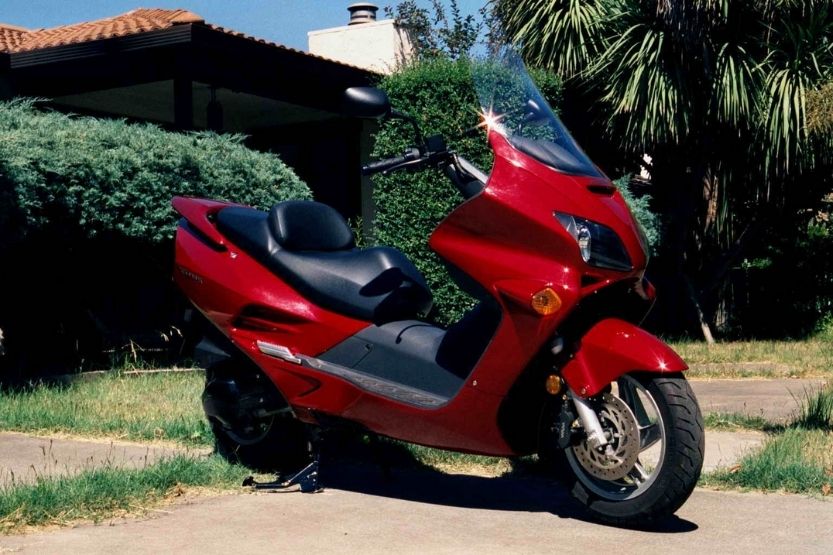
Honda always had a reputation for building some of the most reliable motorcycles around. One of these is the legendary Honda Cub that can survive any kind of abuse and still run like a champ. The Honda NSS250 is in the same boat.
Although the engine of the Reflex is not that DIY-friendly, you will need to take it to a certified mechanic if you need it repaired. However, you can easily do the necessary maintenance tasks, like changing the oil and replacing light bulbs by yourself.
Can you take the Reflex on long-distance trips? Yes, you can. Thousands of Reflex owners have done 1,000-mile+ rides. Most of them have not run into any major problems whatsoever.
If your scooter is in good condition (keep in mind that you need to change the drive belt every 12k miles), then you should be able to take long-distance trips with no problems at all.
Again, what are the specs of Honda Reflex? The Honda Reflex, aka Reflex or Forza, is a maxi-scooter weighing 375 lb (170.1 kg) with a liquid-cooled 249 cc engine. Its top speed is 85 mph (137 km/h).
Honda Reflex Pros
1. Has a Reliable and Long-lasting Engine
Because the Reflex’s engine is not stressed to get as much horsepower, it prevents much wear and tear. This means you can push the odometer well beyond the 100k mark, even more, when you properly maintain the bike.
2. Has Exceptional Gas Mileage
The Honda Reflex 250 can get an impressive number of miles per gallon for a 250cc maxi-scooter. For mixed city and highway riding, the Reflex can get around 65 miles. If you are an ultra-miler, you might get around 80 to 85 miles per gallon.
3. Boasts of a Decent Top Speed for a Maxi-scooter
The most impressive thing about this scooter is its top speed of 75-80mph. This means you can keep up with the other vehicles if you were to take this bike on the highway.
4. Lightweight for a 250cc Bike
You might think that this bike weighs around 500-600 pounds based on how long and wide it is. However, this is just around 375 pounds dry. This is the reason why the Reflex can go as fast as it does.
5. Easy to Maintain
You can easily access the oil pan plug for easy oil changes and get to the engine by removing one panel. If you have competent mechanic skills, then you can do your repairs. However, at the very least, you can do all the necessary maintenance tasks yourself.
6. Lots of Storage Space
There is a lot of space underneath the seat, which should be quite evident given how wide this scooter is. You will find that the under-seat storage is big enough to fit two helmets or anything that has roughly the same bulk. The storage is so big that Honda placed an automatic light inside so you can see your stuff.
Honda Reflex Cons

1. Not so Impressive Acceleration
Because this scooter is made for casual cruising, it does not have that much spring in its step. The Reflex has a kind of acceleration dead spot when you hit the 25-40 miles per hour range. This is due to the CVT shifting up a bit too early. Also, note that getting the Reflex to its top speed can be challenging because of the low-stressed engine.
2. Might Get Blown off the Highway
The Honda Reflex’s lightweight works against it when you decide to use the highway. Although the bike is 375 pounds, passing cars can still blow this bike off the road, much more if it was a truck that was to pass by. If you are thinking of taking the Reflex on the highway, stay on the rightmost lane.
3. The Suspension Is Not so Great
The Honda Reflex is great for city roads and maybe even the outskirts. However, if you venture into the rural territories, you will feel every bump. Although the rear shocks are adjustable, increasing the travel length will only make the rear of the bike bouncy.
4. They Are Quite Expensive
Honda vehicles have a reputation for retaining their value for a long time. This is a good thing if you already own a Honda Reflex. However, if you are still shopping around for one, expect to pay above $1k for a decent secondhand unit. You may need to pay higher for a low-mileage and well-maintained unit.
5. Lots of Aftermarket Parts
From additional storage boxes to modified windshields, you will not be at a loss when it comes to aftermarket accessories and parts for the Honda Reflex. You can make your Honda Reflex truly unique by adding aftermarket parts that suit your personality and riding style.
Honda Reflex Common Issues
Faulty Fuel Pump
There have been many reports of the Reflex running just fine for around half an hour or so before the engine suddenly dying. This is typically due to a faulty fuel pump. The pump would prime just fine when the bike starts, and it will fill the carburetor’s bowl but will then stop. The bike will essentially run out of fuel and then die.
Start Button Safeguards Gum Up Easily
The Reflex has a safety feature where you will not start the bike without squeezing the rear brake fully. After a while, the button behind the brake lever would not go all the way in. This requires you to squeeze the brakes hard to get the engine to start. You need to clean this safety button every once in a while to prevent this problem.
How to Make the Honda Reflex Go Faster
The biggest problem users have with the Honda Reflex is the pronounced acceleration dead spot at around 30mph. You can fix this problem by removing a couple of the weights from the CVT variator, known as the K-mod.
The variator has three 31g weights on long ramps and another three 21g weights on short ramps. All you need to do is remove the three lighter weights. This will cause the CVT to shift as it reaches a higher RPM. It will also prevent the huge drop in power and allow the Reflex to accelerate much faster.
You can also swap the variator from the Reflex with one from a Honda Big Ruckus (PS250). These scooters have the same engine, but the Ruckus has a better transmission. However, keep in mind that using the Ruckus variator will affect the top speed of the Reflex.
Conclusion – Honda Reflex 250 Review
The Honda Reflex, also known as the NSS250, is a maxi-scooter produced by Honda from 2001-2007. This scooter weighs just 375 pounds and is powered by a single-cylinder 249cc OHC gasoline engine. Even though the engine can only put out up to 19 horsepower, it is enough to push the Reflex to speeds reaching 82 miles per hour.
If you are in the market for a good and reliable maxi-scooter and have a sizeable budget, then check out the Honda Reflex. It is a scooter that feels right riding in the city. It is also fun for long-distance trips.
Although it has been almost 15 years since the last Reflex came off the Honda production floor, these are still some of the most sought-after scooters today. You can, therefore, consider yourself lucky if you own one.
Related reading:


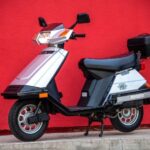


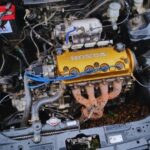

![Read more about the article Mazda vs Honda [Is Mazda More Reliable than Honda?]](https://roadsumo.com/wp-content/uploads/2020/12/mazda-vs-honda-300x200.jpg)
